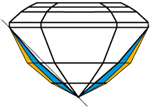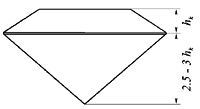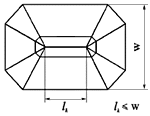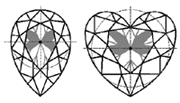| FANCY CUTS | ||||||||||||||||||||||||
|
|
||||||||||||||||||||||||
| Evaluation of fancy cuts of
diamonds should be based on the following factors:
Fancy shapes are applied to increase the yield, i.e. to keep the maximum weight of a diamond. For large stones, 40-50% is considered to be the maximum possible yield (ratio of the polished diamond weight to the original diamond weight, in percentage), while the yield of fancy cuts can range up to 70-80%; Any noncircular diamond shape implies significant changes of the angles between the pavilion facets and the girdle plane, which inevitable results in decreasing total internal reflection. Evaluation of many cut parameters is often subjective and depends on the appeal and brilliance of a stone. In any case, length, width, and depth of a stone should be measured (width is taken as 100% in the calculation of all other parameters and proportions). |
||||||||||||||||||||||||
| Proportions
|
||||||||||||||||||||||||
|
The table size is determined by direct measurement with a loupe with micrometric scale (microscale) and is expressed as a percentage of the stone width. This parameter can vary widely in fancy shapes, unlike that in round shapes. The optimal table size is 55-65% for wedge cuts and up to 70-75% for step cuts. |
||||||||||||||||||||||||
|
The crown angle is evaluated by eye. A stone is observed from the side (along its long axis), and the angle is indicated as: Very Shallow The crown angle of a round cut is taken as normal (acceptable), i.e. the profile view of a fancy-cut diamond should be close to that of a diamond with a round brilliant cut. The crown angle of step-cut diamonds is determined by the tilt of the crown facets of the middle stage. |
||||||||||||||||||||||||
|
The girdle thickness is evaluated in the same way as that of round stones. It should be noted that the girdle thickness can be significantly increased at the tips of marquise, heart, and pear, and in the cleft of heart. |
||||||||||||||||||||||||
|
The pavilion depth is evaluated by eye in profile examination and is indicated as: - Very shallow
|
||||||||||||||||||||||||
|
|
||||||||||||||||||||||||
|
The length/width ratio is determined by dividing the stone length by its width. It usually ranges within a tolerance range, which is specified for each fancy cut style. At first, the length should be divided by width. The quotient is length (as a rule > 1) and stands before the colon. The widths is always taken as unity and stands after the colon. Then the resulting ratio is used as a key to determine the shape characteristics from the table.
The optimal length/width ratio is determined by the following conditions:
Traditional (conservative) ideas about what a diamond of one or another shape should look like. For example: an oval shape should not be similar to a round shape, and a baguette should differ markedly from a square. Requirements of jewelry production: the length/width ratio should be strictly determined from the standpoint of mounting stones in serial jewelry works. |
||||||||||||||||||||||||
 The
pavilion bulge is determined for step-cut stones. This parameter is
evaluated visually in profile examination as follows (see picture): The
pavilion bulge is determined for step-cut stones. This parameter is
evaluated visually in profile examination as follows (see picture):
- Slight A slight bulge is tolerated for well-cut stones with a step cut. The pavilion angle should range about 48o (relative to girdle) for of the upper-stage facets, about 41o for the middle-stage facets, and about 34o for the lower-stage facets. |
||||||||||||||||||||||||
|
· Slight · Too deep or too shallow pavilion; · Length/width ratio slightly greater than the optimal value, i.e. a significant pavilion angle variation takes place. |
||||||||||||||||||||||||
|
|
||||||||||||||||||||||||
| Symmetry | ||||||||||||||||||||||||
|
|
||||||||||||||||||||||||
|
· Culet too high The normal position of the culet is regarded in the center of the imaginary circle (see picture). Symmetry irregularities are classified as major and minor.
| ||||||||||||||||||||||||
|
The shape appeal is determined visually according to the table and is characterized with major and minor features.
Shape appeal is a parameter which describes the deviation of the stone shape (outline) from the commonly accepted standard shape. When shape appeal is evaluated, symmetry features are not considered.
|
||||||||||||||||||||||||
|
|
 The
pavilion depth of a round brilliant can be taken as optimal (the same
approach as in crown evaluation). The ratio of the pavilion depth
to the crown height is an important parameter which determines the
proportions of a stone (crown height, pavilion depth, and table size).
This ratio can be estimated visually in profile examination (see
picture), i.e. a grader should determine approximately how many
crown heights fit the pavilion depth. If this ratio ranges within
2.5-4.5, the proportion of the crown height and pavilion depth is
considered tolerable for a given fancy cut with a certain table size
and total depth.
The
pavilion depth of a round brilliant can be taken as optimal (the same
approach as in crown evaluation). The ratio of the pavilion depth
to the crown height is an important parameter which determines the
proportions of a stone (crown height, pavilion depth, and table size).
This ratio can be estimated visually in profile examination (see
picture), i.e. a grader should determine approximately how many
crown heights fit the pavilion depth. If this ratio ranges within
2.5-4.5, the proportion of the crown height and pavilion depth is
considered tolerable for a given fancy cut with a certain table size
and total depth.  The
culet size of fancy-cut stones is determined by the same method as
that for round diamonds. If a stone has an elongated culet (keel),
the keel width is estimated. In step-cut stones, the keel length,
as a rule, does not exceed the keel width.
The
culet size of fancy-cut stones is determined by the same method as
that for round diamonds. If a stone has an elongated culet (keel),
the keel width is estimated. In step-cut stones, the keel length,
as a rule, does not exceed the keel width.  The position of the culet of the stones having a heart or pear shape is evaluated with unaided eye and can be indicated as:
The position of the culet of the stones having a heart or pear shape is evaluated with unaided eye and can be indicated as: